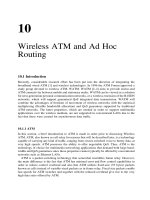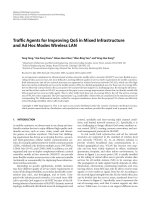Wireless ATM and Ad Hoc Routing
Bạn đang xem bản rút gọn của tài liệu. Xem và tải ngay bản đầy đủ của tài liệu tại đây (273.61 KB, 26 trang )
10
Wireless ATM and Ad Hoc
Routing
10.1 Introduction
Recently, considerable research effort has been put into the direction of integrating the
broadband wired ATM [1] and wireless technologies. In 1996 the ATM Forum approved a
study group devoted to wireless ATM, WATM. WATM [2–4] aims to provide end-to-end
ATM connectivity between mobile and stationary nodes. WATM can be viewed as a solution
for next-generation personal communication networks, or a wireless extension of the B-ISDN
networks, which will support guaranteed QoS integrated data transmission. WATM will
combine the advantages of freedom of movement of wireless networks with the statistical
multiplexing (flexible bandwidth allocation) and QoS guarantees supported by traditional
ATM networks. The latter properties, which are needed in order to support multimedia
applications over the wireless medium, are not supported in conventional LANs due to the
fact that these were created for asynchronous data traffic.
10.1.1 ATM
In this section, a brief introduction to ATM is made in order prior to discussing Wireless
ATM. ATM, also known as cell-relay for reasons that will be described later, is a technology
capable of carrying any kind of traffic, ranging from circuit-switched voice to bursty data, at
very high speeds. ATM possesses the ability to offer negotiable QoS. Thus, ATM is the
technology of choice for multimedia networking applications that demand both large band-
widths and QoS guarantees since these properties cannot typically be offered by conventional
networks such as Ethernet LANs.
ATM is a packet-switching technology that somewhat resembles frame relay. However,
the main difference is the fact that ATM has minimal error and flow control capabilities in
order to reduce control overhead and also that ATM utilizes fixed-size (53 bytes) packets
known as cells instead of variable-sized packets as in frame relay. Fixed size packets enable
fast speeds for ATM switches and together with the reduced overhead give rise to the very
high data rates offered by ATM.
The ATM protocol architecture is shown in Figure 10.1. Its main parts are:
†
Physical layer. It involves the specification of the transmission medium and the signal
encoding to be used. The two alternative speeds offered by the physical layer are 155 and
622 Mbps.
†
ATM layer. This defines the transmission of ATM cells and the use of connections either
between users, users and network entities or between network entities. These connections
are referred to as Virtual Channel Connections (VCCs) and are analogous to the data link
connections in frame relay. VCCs can carry both user traffic and signaling information. A
collection of VCCs that share the same endpoints is known as a Virtual Path Connection
(VPP).
†
The ATM Adaptation Layer (AAL). This layer maps the cell format used by the ATM layer
to the data format used by higher layers. Thus, at the transmitting side, AAL maps frames
coming from higher layers to ATM cells and hands them over to the ATM layer for
transmission. On the receiving side, ATM reassembles cells into the respective frames
and passes frames to upper layers. A number of AALs exist, each of which corresponds to
a specific traffic category. AAL0 is virtually empty and just provides direct access to the
cell relay service. AAL1 supports services that demand a constant bit rate, which is agreed
during connection establishment and must remain the same for the duration of the connec-
tion. This category of service is known as Constant Bit Rate (CBR) service with typical
examples being voice and video traffic. AAL2 supports services that can tolerate a variable
bit rate but pose limitations regarding cell delay. This category of service is known as
Variable Bit Rate (VBR) service with typical examples being transmission of compressed
(e.g. MPEG) video where bit rate can vary, however, delay guarantees are needed to avoid
jerky motion. AAL3/4 and AAL5 support variable-rate traffic with no delay requirements.
Such categories are VBR traffic with no delay bounds, Available Bit Rate (ABR), which is
a best effort service that guarantees neither rate nor delay but only minimum and maxi-
mum rate and Unspecified Bit Rate (UBR) which is essentially ABR without a minimum
rate guarantee.
The protocol architecture shown in Figure 10.1 also defines three separate planes. These are:
(a) the user plane, which provides for transfer of user information and associated control
information (e.g. FEC, ARQ); (b) the control plane, which performs call control and connec-
tion control; and (c) the management plane, which includes plane management for manage-
ment of the whole system and coordination of the planes and layer management for
management of functions relating to the operation of the various protocol entities.
Wireless Networks274
Figure 10.1 ATM protocol architecture
10.1.2 Wireless ATM
A simple network architecture for WATM is shown in Figure 10.2. It consists of a number of
small cells, each of which contains a BS. The basic role of the base station is interconnection
of the wireless and wired segment of the network. Each cell contains a number of mobile
ATM-enhanced terminals. All terminals inside a cell communicate only with the cell’s BS
and not between each other. To support mobile terminals, BSs are connected to mobility-
enhanced ATM switches. These in turn are interconnected by regular switches in the ATM
backbone network. ATM switching is used for intercell traffic. Terminals are capable of
roaming between cells and this gives rise to the need for techniques for efficient location
management and efficient handoff.
There are proposals for two different scenarios [5] regarding the functionality of the BS in
the above architecture. The first scenario calls for termination of the ATM Adaptation Layer
(AAL) at the BS. In this case, the traffic transmitted over the wireless medium is not in the
format of ATM cells. Rather a custom wireless MAC is used that encapsulates one or more
ATM cell into a single packet. Using this grouping procedure, the overhead due to the header
needed for wireless transmission is less than it would be for wireless transmission of single
ATM cells. In the second, the BS relays ATM cells from the BS towards both the wired
segment of the network and the mobile terminals.
ATM implementation over the wireless medium poses several design and implementation
challenges that are summarized below:
†
ATM was originally designed for a transmission medium whose BERs are very low (about
10
210
). However, wireless channels are characterized of low bandwidth and high BER
values. It is questioned whether ATM will function properly over such noisy transmission
channels.
†
ATM calls for a high resource environment, in terms of transmission bandwidth. However,
Wireless ATM and Ad Hoc Routing 275
Figure 10.2 WATM network architecture
as we have seen, the wireless medium is a scarce resource that calls for efficient use of
medium. However, an ATM cell carries a header, which alone poses an overhead of about
10%. Such an overhead is undesirable in wireless data networks since it reduces overall
performance. This problem can be alleviated by performing header compression. ATM
was designed for stationary hosts. In the wireless case, users may roam from one cell to
another thus causing frequent setup and release of virtual channels. Thus, fast and efficient
mechanisms for switching of active VCs from the old wireless link to the new one are
needed. When the handover occurs, the current QoS may not be supported by the new data
path. In this case, a negotiation is required to set up new QoS. Handover algorithms should
take those facts into consideration.
10.1.3 Scope of the Chapter
The remainder of this chapter discusses a number of issues relating to wireless ATM. It is
assumed that the reader possesses basic knowledge on ATM. In Section 10.2, wireless ATM
architecture is discussed covering issues related to the protocol stack of wireless ATM. This
section also discusses location management and handoff in wireless ATM networks. Section
10.3 discusses HIPERLAN 2, an ATM-compatible WLAN developed by the European Tele-
communications Standards Institute (ETSI). Contrary to WLAN protocols, HIPERLAN 2 is
connection oriented and ATM-compatible. Slightly deviating from the contents of this chap-
ter, Section 10.4 presents a number of routing protocols for multihop ad hoc wireless
networks. Finally, the chapter ends with a brief summary of its contents in Section 10.5.
10.2 Wireless ATM Architecture
The protocol architecture currently proposed by the ATM Forum is shown in Figure 10.3.
The WATM items are divided into two parts: mobile ATM, which consists of a subpart of
the control plane, and radio access layer (shaded items in the figure). Mobile ATM deals with
the higher-layer control/signaling functions that support mobility. The radio access layer is
responsible for the radio link protocols for wireless ATM access. Radio access layers consists
of the physical layer, the media access layer, the data link layer, and the radio resource
control. Up to now, only PHY and MAC are under consideration. The protocols and
approaches for DLC and RRC have not been proposed yet. The physical, MAC and DLC
layers for the radio access layer are briefly discussed below, while mobile ATM issues are
discussed in later sections.
Wireless Networks276
Figure 10.3 WATM protocol architecture
10.2.1 The Radio Access Layer
10.2.1.1 Physical Layer (PHY)
Fixed ATM stations can typically achieve rates ranging from 25 to 155 Mbps at the PHY
layer. However, due to the use of the wireless medium, such speeds are difficult to achieve in
WATM. Thus, typical bit rates for WATM PHY are in the region of 25 Mbps, corresponding
to the 25 Mbps UTP PHY option for wired ATM. Note that 25 Mbps is the speed at the
physical layer. WATM VCs will typically enjoy bit rates ranging from 2 to 5 Mbps sustained
and from 5 to 10 Mbps peak. Nevertheless, higher PHY speeds are possible and WATM
projects under development such as the MEDIAN project succeeded in achieving data rates
of 155 Mbps by employing OFDM transmission at 60 GHz. As far as hardware is concerned,
WATM modems should be able to support burst operation with relatively small preambles in
order to support transmission of small control packets and ATM cells and cope with delay
spreads ranging from 100 to 500 ns.
The suggested physical layer requirements for WATM [6] are shown in Figure 10.4. Apart
from the modulation techniques shown in the figure, a number of others have been
proposed[3], such as equalized QPSK/GMSK, equalized QAM and multicarrier techniques
such as OFDM. Of these, the most promising seem to be equalized QPSK/GMSK, which is
simple to implement and can cope with moderate delay spreads (,250 ns) and OFDM which
is more robust to interference and larger delay spreads. CDMA transmission, although effi-
cient for frequency reuse and multiple access is not a potential candidate for WATM, because
of the low DLC data rates it will offer due to spreading.
10.2.1.2 MAC Layer
A number of MAC protocols have been proposed for WATM [5,7]. Most of the proposals
describe a form of a centralized TDMA system in which the frames are divided into two parts:
one contention part, which is used by the mobiles to reserve bandwidth for transmission and
one part in which information is transmitted.
Some general requirements for an efficient WATM MAC protocol are the following [5]:
†
Allow for decreased complexity and energy consumption at the mobile nodes.
†
Provide a means of supporting negotiated QoS under any load condition.
†
Support the standard ATM services, such as UBR, ABR, VBR and CBR traffic classes.
†
Provide adequate support for QoS-demanding traffic classes.
†
Provide a low delay mechanism of channel assignment to connections.
Wireless ATM and Ad Hoc Routing 277
Figure 10.4 Physical layer requirements for WATM
†
Support Peak Cell Rate (PCR), Sustainable Cell Rate (SCR), and Maximum Burst Size
(MBS) requests.
†
Support multiple physical layers. For example, the same MAC functionality should be
able to operate over the 5 GHz and 60 GHz physical layer options.
†
Efficiently manage and reroute ATM connections as users move while maintaining nego-
tiated QoS levels.
†
Provide efficient location management techniques in order to track mobiles and locate
them prior to connection setup.
WATM, being a member of the ATM family, provides support for applications, like multi-
media, which are characterized by stringent requirements, such as increased data rates,
constant end-to-end delay and reduced jitter. Traditional WLANs cannot support those
requirements, and have limited support for QoS applications, as we mentioned before. As
a result, considerable research projects target the area of WLANs using ATM technology
(WATM LANs). Such a project is HIPERLAN 2, a standard being developed by ETSI. The
standard is described in later sections.
10.2.1.3 DLC Layer
The DLC layer interfaces the ATM layer to lower layers. Thus, in order to hide the deficien-
cies of the wireless medium from the ATM layer, DLC should implement error detection,
retransmission and FEC. Different levels of coding redundancy might be used in order to
support each ATM service class.
The DLC layer exchanges 53-byte ATM cells with the ATM layer above it. A DLC PDU is
a packet that may consist of one or more cells. This packet is handed down to the physical
layer for transmission as a single unit. The use of a multicell DLC packet reduces overhead
but requires functionality to convert between the ATM cell format and the DLC packet
format.
10.2.2 Mobile ATM
10.2.2.1 Location Management/Connection Establishment
Existing protocols for connection setup in ATM assume that the location of a terminal is
fixed. Thus, the terminal’s address can be used to identify its location, which is needed in
processes such as call establishment. However, when terminals become mobile, this is no
longer true and additional addressing schemes and protocols are needed to track the mobile
ATM terminal.
Location management in a wireless ATM network can be either external to the connection
procedure or integrated[3,8]. Here we describe the latter option. Each mobile terminal served
by the network is associated with a ‘home’ BS or switch which provides it with a home ATM
address. When the terminal moves to another cell, it is assigned a foreign address via this
cell’s BS. The home switch maintains a pointer from the permanent home address to the
current foreign address of the mobile. This pointer maintenance is achieved by terminal
transmission of address updates as they move to new cells. Connections to a mobile terminal
are then established with a simple extension to the standard Q.2931 signaling procedure
specified in existing ATM specifications. When a connection needs to be established to a
Wireless Networks278
specific terminal, a SETUP message is issued with the home address of the mobile as the
destination. If the mobile is under coverage of its ‘home’ BS the connection is established. If
the mobile has roamed to another cell, a RELEASE message is returned towards the source
that requested the connection. The RELEASE message carries the foreign address of the
terminal. Upon reception of the RELEASE message, the source can then issue a SETUP
message with the terminal’s foreign address as the destination. Thus, the connection with the
roamed terminal will be set up.
10.2.2.2 Handover in Wireless ATM
The mobility nature of terminals in WATM networks means that the network must be able to
dynamically switch ongoing connections of users that roam between cells. Handovers take
place when mobiles move out of the coverage of a BS towards the coverage of a new one. In
such a case the signal measurement at the mobile of the new BS gets stronger while that of the
previous one weakens. Handoff can be network-controlled, mobile-assisted or mobile-
controlled. In the first case, the mobile terminal is completely passive and all signal measure-
ments and handoff initiations are a responsibility of the BS. In the second case, both the BS
and the mobile terminal perform signal measurements, however, the handoff initiation is a
responsibility of the BS. Finally, in the third case both the BS and the mobile terminal
perform signal measurements and the handoff initiation is a responsibility of the mobile
terminal.
A handover should be done in an efficient way such that the user does not notice perfor-
mance degradation. Of course, there is a chance of the handoff being blocked. This means that
the new BS is not able to serve the connections of the roaming user, either for reasons of
bandwidth availability or due to the fact that it cannot guarantee the QoS of the user’s
connection. In the latter case, however, a renegotiation towards a lower level of QoS
might be carried out in order for the connection to be kept alive.
A handoff generally involves switching the VCs of the roaming terminal from the former
BS to the current one while maintaining route optimality and QoS to the maximum possible
extent. A typical handoff in a wireless ATM network consists of the following phases[3]:
†
The terminal initiates the handoff. This is done by sending a message to its current BS in
order to initiate the procedure of moving the connection from the current BS to the new
one.
†
The network switches and BSs collectively determine the switch from which to reroute
each VC. This switch is known as a ‘crossover switch’ (COS). When the handover occurs,
the current QoS may not be supported by the new data path. In this case, a negotiation is
required to set up new QoS. Handover algorithms should take those facts into considera-
tion. Related to this fact is the identification of the optimal COS to be used in order to
switch the connection. COs may be initiated either at the old or the new BS.
†
Upon determination of the COS, the network routes a subpath from the COS to the new
BS.
†
Over the above path, the cell stream is switched to the new BS.
†
The unused subpath from the COS to the old BS is released.
†
Finally, the terminal drops its radio connection with the old BS, connects to the new one
and confirms end-to-end handoff.
Wireless ATM and Ad Hoc Routing 279
To minimize QoS disruption during the handoff, the network can perform a ‘lossless handoff’
[8]in order to maintain cell delivery in sequence without loss to the mobile terminal. This
involves buffering of traffic in transit during the handoff process. Specifically, the COS sends
a ‘marker’ ATM cell to the current BS before switching the terminal’s connections to the new
one. From that point onwards, when ATM cells are received at the new BS from the COS,
these are buffered until the handoff is confirmed by the mobile terminal. Furthermore, the
current BS buffers traffic received between the arrival of the marker cell and the arrival
handoff confirmation. Upon this confirmation, the current BS forwards buffered traffic to
the new BS. Finally, the new BS relays to the terminal the buffered cells from the current BS
followed by the buffered cells from the new one. Thus, lossless, in-sequence delivery is
achieved.
In order to support WATM handoff, a number of extensions to ATM signaling protocols
have been proposed [3,8].
10.3 HIPERLAN 2: An ATM Compatible WLAN
HIPERLAN 2 [9–11] aims to provide high speed access (up to 54 Mbps at the physical layer)
to a variety of networks including 3G networks, ATM and IP based networks and for private
use as a wireless LAN system. Supported applications include data, voice and video, with
specific QoS parameters taken into account. In contrast to the WLAN systems described in
Chapter 9, HIPERLAN 2 is a connection-oriented system which uses fixed size packets.
HIPERLAN 2 is compatible with ATM. Its connection-oriented nature makes support for
QoS applications easy to implement. In the following subsections, we describe the main
aspects of HIPERLAN 2.
10.3.1 Network Architecture
The HIPERLAN 2 standard adopts an infrastructure topology. As shown in Figure 10.5, the
network coverage area comprises a number of cells, with traffic in each cell being controlled
by an Access Point (AP). Mobile terminals within a cell communicate with the cell’s AP
through the HIPERLAN 2 air interface. Direct communication between two mobile terminals
is also possible, however. this procedure is still in the development phase. Each mobile
terminal can communicate only with one AP (that of the current cell). In order for such a
communication to take place, an association procedure must first take place between the AP
Wireless Networks280
Figure 10.5 HIPERLAN 2 network architecture
and the mobile terminal. After the association takes place, mobile terminals can freely move
within the coverage area of the HIPERLAN 2 network while maintaining their logical
connections. Moving to another cell is made possible through a handover procedure. The
APs automatically configure the network by taking into account changes in topology due to
mobility. Association and handover are revisited later in this section.
Being compatible with ATM, HIPERLAN 2 is a connection-oriented network using fixed
size packets. Signaling functions are used to establish connections between the mobile nodes
and the AP in a cell and data is transmitted over these connections as soon as they are
established, using a time division multiplexing technique. The standard supports two types
of connections: bi-directional point-to-point connections between a mobile node and an AP,
and unidirectional point-to-multipoint connections carrying traffic to the mobile nodes.
Finally, there is a dedicated broadcast channel used by the AP to transmit data to all mobiles
within its coverage.
The connection-oriented nature of HIPERLAN 2 makes support for QoS applications easy
to implement. Each connection can be created so as to be characterized by certain quality
requirements, like bounded delay, jitter and error rate. This support enables the HIPERLAN 2
network to support multimedia applications in a way similar to the ATM network.
HIPERLAN 2 also provides support for issues like encryption and security, power saving,
dynamic channel allocation, radio cell handover, power control, etc. However, most of these
issues are either not standardized yet or left to the vendors to implement.
10.3.2 The HIPERLAN 2 Protocol Stack
The protocol stack for the HIPERLAN 2 standard is shown in Figure 10.6. It comprises a
control plane part and a user plane part following the semantics of ISDN functional partition-
ing. The user plane includes functionality for transmission of traffic over established connec-
tions, and the control plane provides procedures to control established connections. The
protocol has three basic layers: the Physical Layer (PHY), the Data Link Control (DLC)
layer, and the Convergence Layer (CL). At the moment, only the DLC includes control plane
functionality. The various layers are discussed below.
Wireless ATM and Ad Hoc Routing 281
Figure 10.6 The HIPERLAN 2 protocol stack
10.3.2.1 HIPERLAN 2 Physical Layer
HIPERLAN 2 is characterized by high transmission rates at the physical layer, up to 54 Mbps.
The use of OFDM in the physical layer effectively combats the increased fading occurrence
experienced in indoor radio environments, such as offices, etc., where the transmitted radio
signals are subject to reflection from a number of objects, thus leading to multipath propaga-
tion and consequently ISI. The channel spacing is 20 MHz with 52 subcarriers used for each
channel. Of these, 48 subcarriers carry actual data and the remaining four are used as pilots in
order to perform coherent demodulation.
HIPERLAN 2 is able to adapt to changing radio link quality through a Link Adaptation
(LA) mechanism. Based on received signal quality which depends both on the AP-mobile
terminal relative position and interference from nearby cells, LA dynamically selects the
method of modulation and the Forward Error Correction (FEC) code to use in an effort to
provide a robust physical layer. The alternative modulation methods are BPSK, QPSK, 16
QAM and 64 QAM. FEC is performed by a convolutional code with rate 1/2 and constraint
length 7. The physical layer alternatives offered by LA are shown in Figure 10.7.
10.3.2.2 HIPERLAN 2 Data Link Control (DLC) Layer
The DLC layer is used to establish the logical links between APs and the MTs. The DLC layer
comprises a number of sublayers providing medium access and connection handling services
to upper layers. The DLC layer consists of three sublayers: the Medium Access Control
(MAC) sublayer, the Error Control (EC) sublayer and the Radio Link Control (RLC)
sublayer.
10.3.2.2.1 MAC Protocol and Channel Types The MAC protocol used by HIPERLAN 2 is
based on time-division duplex (TDD) and dynamic time-division multiple access (TDMA).
MAC control is centralized and performed by each cell’s AP. The wireless medium is shared
in the time domain through the use of a circulating MAC frame containing slots dedicated
either to uplink or downlink traffic. The length of the MAC frame is fixed at 2 ms and
comprises a number of parts which are not fixed. Rather, their lengths are variable in
nature and are determined by the AP. Uplink and downlink slots within a frame are
allocated dynamically depending on the need for transmission resources. All data from
both mobile terminals and APs is transmitted in dedicated time slots. For mobile terminal
Wireless Networks282
Figure 10.7 HIPERLAN 2 physical layer alternatives









